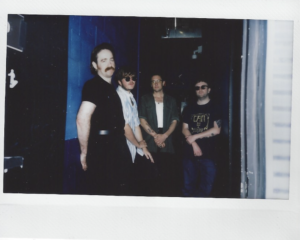Pat Keen in Greenpoint. Photos by Stasia de Tilly.
Wisconsin Boy, Pat Keen, has run the indie circuit playing in bands like Gtoss and Ryan Power. Keen is back with Albatross his first release since 2015. Keen drove up this past weekend for The Ramp Local Records and Wharf Cat Records Northside Festival showcase with fellow label mates Buck Gooter. Pat Keen played acoustic guitar and vocals alongside his band mates, Addie Strei on electric guitar, vocals, and percussion. Leo Strei on bass and vocals, and Cami Mennitte leading drums and percussion.
Sporting a baseball cap Keen drinks a Miller Highlife before his show at a dressed up dive in Greenpoint, we chatted about his 2017 record, Albatross. The new record boasts 12 short and sporadic songs and is supported by artists like Chris Weisman and John Sunde who helped him develop his skills to deliver a well-balanced record.
How did you get your start in music?
I played piano, I would just watch my mom, watch her hands, and she would try to make me read the music but I would just learn it by ear and play it. Then when I was eight I got a guitar but didn’t start playing it till I was ten then I switched to bass when I saw jazz music. I saw the high school jazz band playing at my middle school so I started playing upright bass and later went to the new England conservatory.
So tell me about the new record Albatross.
I came out with a record in 2015 and then moved to New Hampshire and studied under Chris Weisman. We did a lot of guitar theory and he helped me get back into songwriting. I was touring for a while with GToss and Ryan Power and didn’t write a single song — I wasn’t feeling inspired, I was going through a tough breakup time. Then I wrote my last album and I’m still writing now, it hasn’t stopped. I wrote Albatross at the tail end of New Hampshire then I moved back to Minneapolis and wrote some of the songs there and recorded most of it there.
So you’re technically trained in jazz and are experienced with lots of instruments —was this album just you?
Yeah, I played the guitar, bass, drums, and sang. A couple of people sang some harmonies on there.
What was the process like?
I write it all on the acoustic guitar first. I’ll make a melody then write lyrics. I just make the guitar parts as I go and figure it out during recording. Every part I need to teach to my band, I need to relearn or just get them to learn it. I’ve played drums since I was thirteen. But this was the first time I’ve played drums on a record in four years.
Your lyrics seem secondary to vocal melody, how do you introduce lyrics and still keep meaning?
I free write a lot, so I use those words. I have words or ideas I use as lyrics. Most of the time it’s stream of consciousness then it ends up meaning something because your subconscious is related to you. It’s like how your dreams mean something.
Your music is textured and rhythmic, what does that say about your subconscious?
It’s fast moving and that’s sort of who I am. I remember asking myself in college what kind of musician I want to be, what kind of niche do I want to go into. I wasn’t able to decide and wanted to do everything because I love all different types of music. I’m ADHD supremely so I don’t want to dwell on things for too long, in my life also.
Do you think that’s why you were attracted to jazz?
Yeah, it made sense to be able to have that full feeling of expression. I also don’t have a long attention span. That’s why the songs on the record are short — some are 45 seconds long, they’re interludes. But then some songs are 1:15-1:30 maybe. I don’t want to waste anybody’s time really, or just mine.
Do you want to speak on some influences?
Going to school for bass I got exposed to a lot of stuff. I was really into noise and everything DIY. I was in this noise band for a sec. I got into free improvising and then also a love for rock music and songwriters. I think all that shaped who I am. I’ve been getting into songwriters like Jessica Pratt, she’s my favorite. Her lyrics are so meaningful and her melodies and vocals are so strange it’s like a cartoon. I can’t pinpoint why but it just feels the best to listen to. I love Arthur Russell. When I sing I want to sound like him. I realized I wanted to be a singer. I take elements from everywhere. When I’m writing a guitar part I don’t think of the harmony necessarily. It’s all about melody for me.
What’s the goal of Albatross?
The lyrics are about a lot of different things. They’re like pockets about different parts of my life. It ends up meaning things. I usually write to work through things too and finding patterns. I was going through a time with my family where I was coming out of hating my mom in high school then that carrying over into college and being shitty. So I dedicated it to her because I figured it out and I think I figured it out through finishing this record and making it happen. It’s about a lot of things but the main thing is about my personal growth.
Why did you choose Albatross to represent the record?
By Albatross, I didn’t mean the bird. It’s more in the second definition of the word, feeling of guilt or hindrance. I went into to do a podcast with my buddy and he had already analyzed all my lyrics and he had this thing with the rhyme of the ancient mariner and relating it to the albatross.
Whats coming up for you?
The music that I’m writing now is a lot more patient, the songs are longer or just less sections. My new thing is about learning to deal with being super comfortable with friends — with not being cool to them sometimes. It was my mom and now it’s about other people. But it’s all about personal growth.
What was the experience like working with Chris Weisman?
It was so cool. I went in and I told him I was listening to his songs and writing songs and I asked him if I could show him my songs — he didn’t want to hear any of them. Then we did music games and these theories that he has. The goal of them is to open your ear up to hearing more song ideas or musical ideas. We would pick a three note shape on the guitar each randomly and play them together. The talk about what scales were playing or thinking about how scales work. Intense playful music theory stuff. A couple of songs on the last record came from that experience.
You also delved into vocal training for Albatross?
Yeah, I did that with my buddy, John Sunde, who plays under the name J.E. Sunde. His records are really good, I played some upright and electric bass on his last record. I was in the studio and I realized once I had finished guitars and bass on my own, I thought I was done with the vocals but I started tracking the drums and I realized they weren’t good enough. I just never learned how to sing. I called John and he said he’d do it for a bottle of Jameson. So we had three or four sessions where we went through the songs and he taught me about breathing and warm ups — how to think about notes whether you’re coming from above or from below. Making sure you breathe at the right spots and breathe out too. He helped with the recording of the vocals too. He is also a hero of mine. I’ve been watching him play since I was fourteen.
What are some artists that have influenced you?
Aurthur Russell – Love is overtaking me, The Ahmad Jamal Trio, D’angelo, Chris Cohen, Joni Mitchel, Sam Amidon, Land of Talk, Ruth Garbus, Connie Converse.












